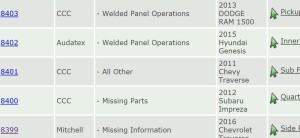
‘What did the DEG say about it?’ Program continuing to make an impact 8,400 inquiries later
By onAssociations | Education | Repair Operations | Technology
At around 8,400 inquiries received to date, the Database Enhancement Gateway has become a part of the collision repair landscape and a valued middleman in the collision repairer-insurer-estimating service relationship.
The program, now in its eighth year and poised to surpass 10,000 inquiries by the end of its tenth, takes inquiries about information providers AudaExplore, Mitchell and CCC.
It then works with the IPs to clarify what’s included in a particular labor-hour estimate; stimulate the development of new database line items for removal, replacement and refinishing work; and refine the existing offerings.
“A win could be a change in the database, or it could be an explanation,” said Art Harris, who’s served as administrator of the DEG for four years.
He said the service’s biggest victories aren’t necessarily the most dramatic ones.
More RDN DEG coverage
- DEG inquiry leads to CCC adding raw bumper prep for numerous Mazdas
- DEG: 5 July tips for auto body shops using Audatex, CCC, Mitchell
- DEG: 5 tips for using CCC, Audatex estimating databases
For example, a Porsche Carrera with the labor time revised by 10 hours is sexy, but a tiny update on the estimate calculations for a Toyota Camry has the potential to make life easier and revenue increase for thousands of repairers, according to Harris.
“One’s repaired more, so it’s a bigger win,” he said.
He gave the example of Inquiry 4818, in which Audatex clarified that the 0.3 hours listed to replace a 2012 Volkswagen Passat’s AC hose referred only to a basic connect/disconnect.
If you had to replace that part, you’d have to write a manual estimate or else you wouldn’t be paid nearly the amount you were due. (The prior year, Audatex gave a similar explanation about a seeming discrepancy in a 2008 Camry’s AC liquid line should be handled.)
 “A small change … can impact the industry significantly,” Harris said.
“A small change … can impact the industry significantly,” Harris said.
Over the eight years, the DEG does get some inquiries over and over again, though Harris noted “there’s always something that’s unique to them.”
He said one frequent inquiry stems from adjusters refusing to pay for addressing weld damage, calling it included.
“We know it’s not,” Harris said.
(“It’s always a class that he (the adjuster) took,” Harris joked: “…’I took a class, they said not to charge.'”)
The other involves color, sand and buff, which aren’t included procedures in the database either.
“Those are really the main two,” he said.
Insurers use it too
Though three collision repair trade groups created and fund the DEG, insurers submit inquiries as well, Harris said — and “it’s not always asking for a reduction in time.”
Harris indicated that the service’s focus on presenting only documentation and facts grants it acceptance among both repairers and insurers.
While it doesn’t happen everyday, he said he often hears anecdotes where a dispute over an estimate leads to an insurer asking “What did the DEG say about it?” or saying, “’Just send it over to the DEG, see what they say.”” Some even have a link to it on online repair portals.
No adjuster “wants to come into a shop and argue,” Harris said.
“It’s a win for both sides because there’s no back and forth,” he said.
Typically, the ideal result is getting a procedure included or granted its own line item.
“Nobody wants to do a manual line,” he said, though the DEG explanation often can help convince an adjuster a shop has a legitimate addition.
That said, the answers the DEG provides don’t always convince an insurer.
“I hear different opinions,” Harris said. Some insurers still ultimately take the stance that Procedure X won’t be reimbursed, no matter what an IP says.
IPs
The information providers are receptive to the DEG’s questions, Harris said, provided they hew to the parameters established at the launch of the DEG. Inquiries must pertain to writing parts and labor estimates using the three services themselves; you can’t use it to ask the IPs for tech support, a price quote or general industry questions.
However, the DEG does compile non-vehicle-specific Top 10 wish lists for each of the three providers; users can upvote each of these options or propose a new one as well.
CCC generally responds in three to four days, and “we can easily have an answer back to the shop” during the repair. AudaExplore and Mitchell take about a “week-plus,” which means the shop can seek a supplement
“I think most of the time, it suffices,” he said.
If a repairer or insurer is getting antsy, Harris recommends calling the information provider and referencing a specific inquiry.
Occasionally, even an IP doesn’t know the answer because the OEM hasn’t provided it yet at all. Inquiry 8299 this year sought details on a 2015 Hyundai Accent from CCC, complaining that the 2016s were already in play. CCC responded that Hyundai still hadn’t given it parts information either. A similar situation also happened this year regarding a 2014 BMW i3.
Those are of course late-model vehicles, and one of them particularly exotic. However, the DEG still once in a while finds “frustrating” situations where a vehicle eight model years or older is corrected following a DEG inquiry.
“What’s happened in the last eight years?” Harris asked, pointing out that such a lag means numerous shops hadn’t been paid during that time.
Other times, an uncorrected repair procedure pops up during less significant model changes, such as a mirror first sold in pieces but then sold as a complete assembly, which means some sort of labor allocation would be required for disassembly.
There are instances where the DEG has to go a step further and prove established or altered OEM procedures to the IPs. Recently, it celebrated how it demonstrated to CCC that Mazda shipped raw bumpers, which the estimating service on its own researched further and concluded it would add a bumper prep option for another 14 vehicle “chapters.”
Harris also recalled instances where he showed tail lamp gaskets were indeed one-time use on a 2012 Toyota Corolla and that a 2014 GMC Sierra required the bed to be lifted before a bumper could be replaced (“That was a win for everybody.”)
The I-CAR Reparability Technical Support portal has “been a significant help” with obtaining that kind of proof, he said.
Other DEG trivia
- Recently, DEG launched weekly tips, which Harris said have been growing in popularity and social media response.
- It is possible to query about aftermarket and recycled parts; for example, wondering about a recycled part requiring different labor time than a new OEM part. In such a case, the DEG would look at the IP’s recycled part guide.
- The oldest model year eliciting a question to the DEG appears to be a 1988 Toyota Standard 4×4. The front bumper inquiry to CCC came in 2013, a quarter-century later. A question does already exist about the newest model year; the writer asked Mitchell about side body sheet metal on the 2016 Chevrolet Traverse.
- There are no queries about Ferraris or Lamborghinis in the DEG. However, Porsche actually has a fair number of inquiries, including higher-ticket models like the 911 family.
- There are already inquiries about the 2015 aluminum F-150: Nos. 7880 and 8131.
- The oldest inquiry to be found in the system appears to be No. 7, in which CCC agreed it was deducting too much overlap time for replacing both inner rails on a 2006 Dodge Ram 1500 Quad Cab and removed 3.5 hours. The most recent, No. 8415, involves a question to AudaExplore about belt molding on the rear doors of a 2012 Ford Expedition.
- The DEG is dedicated to March Taylor, the late owner of Auto Body Hawaii who was the catalyst for the service.
Images
Recent Database Enhancement Gateway inquiries are shown. (Screenshot of www.degweb.org)
Arthur Harris, administrator of the DEG. (Provided by Arthur Harris)
